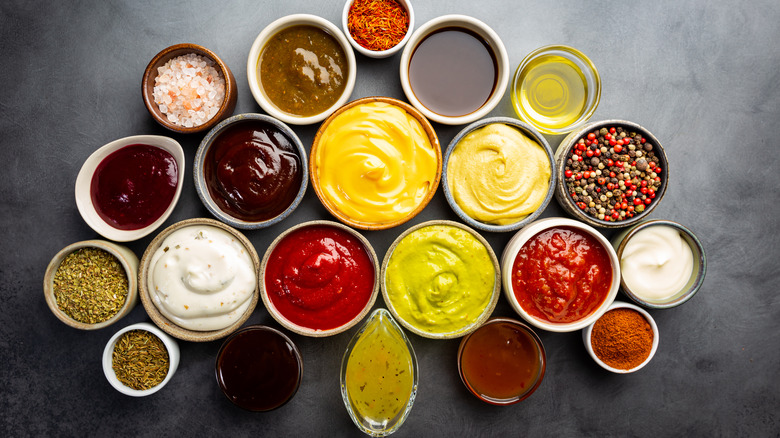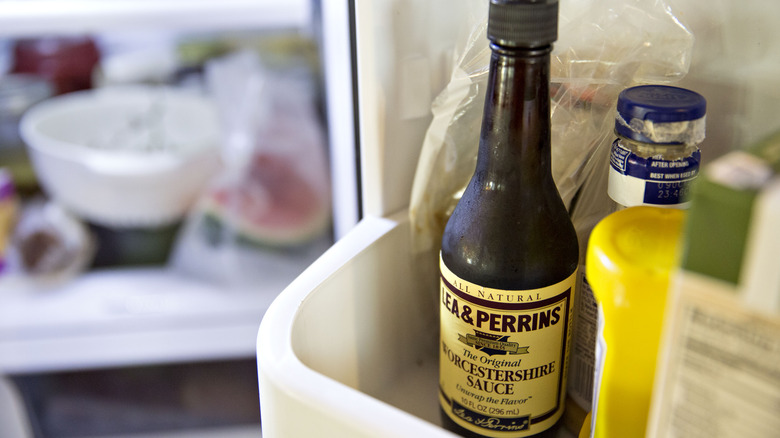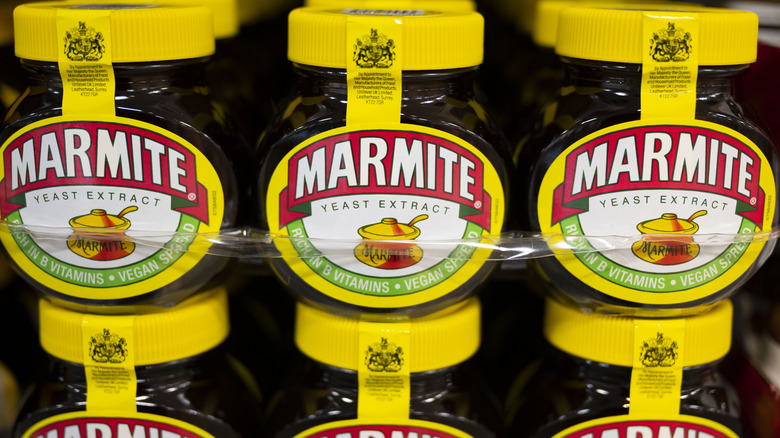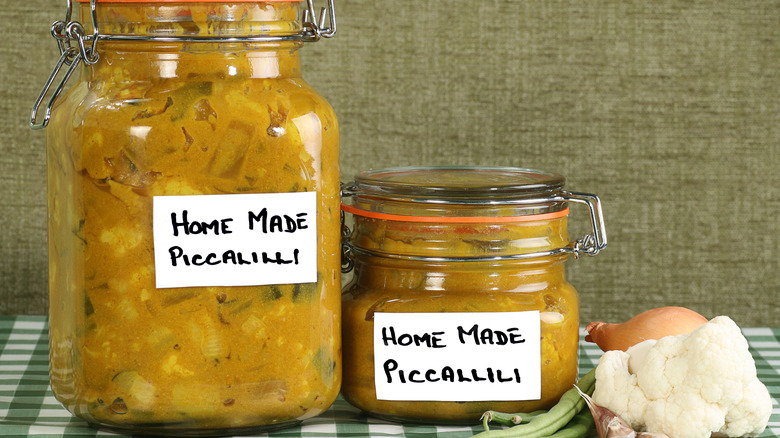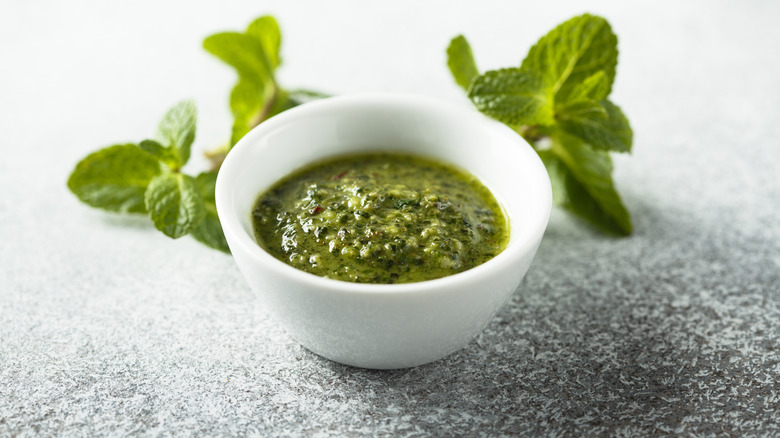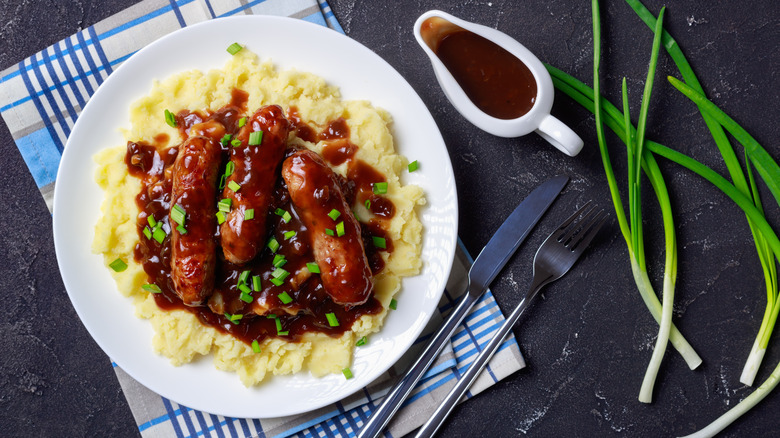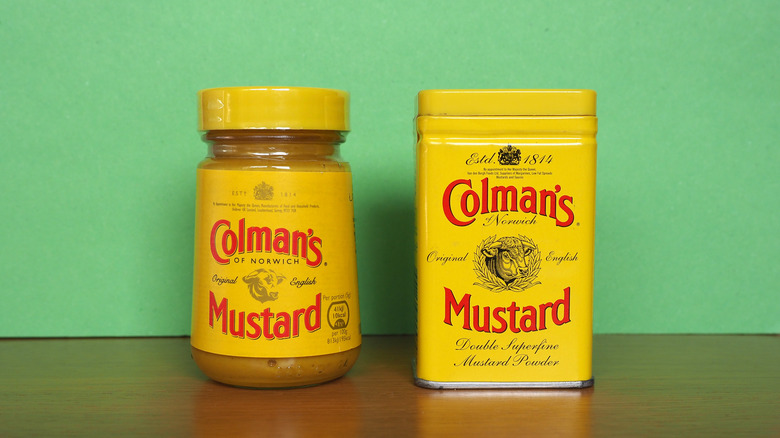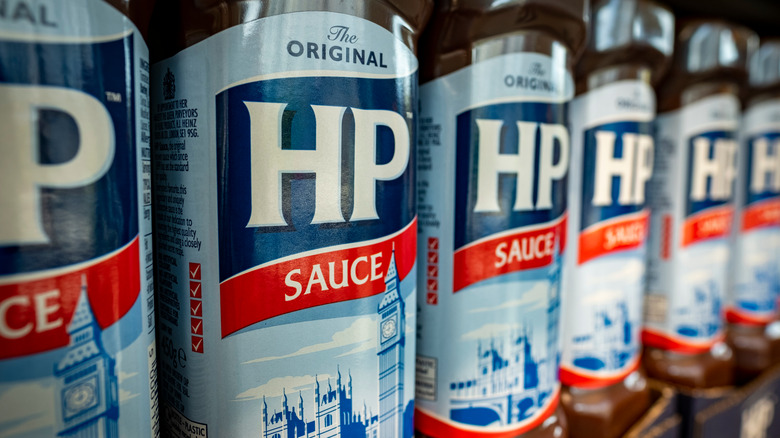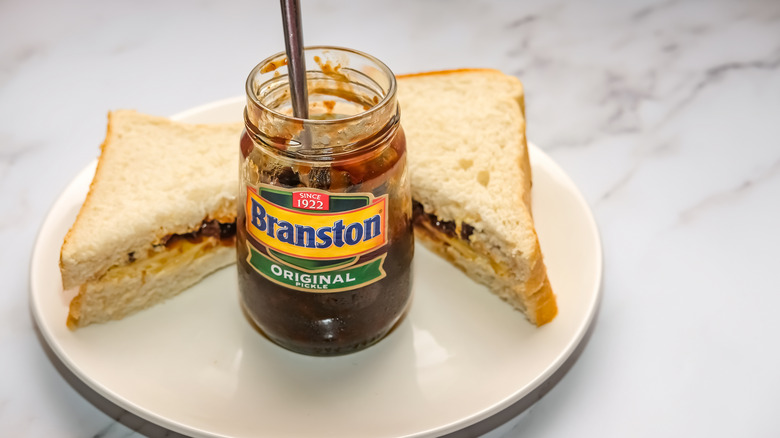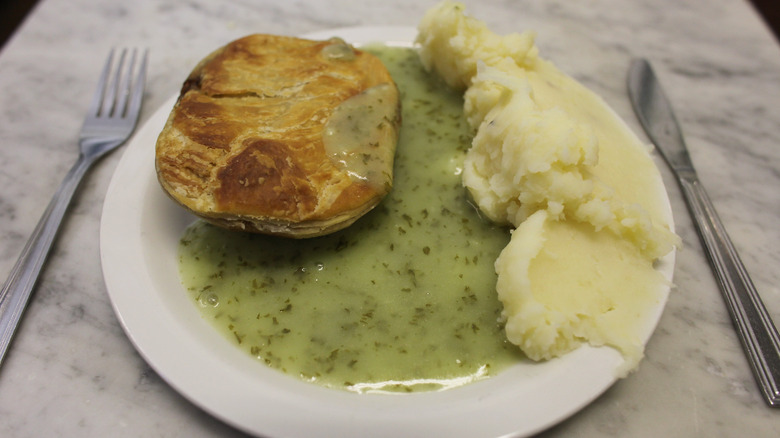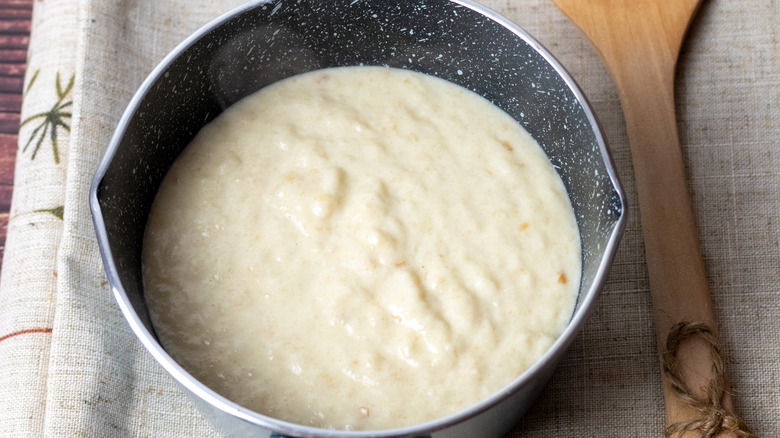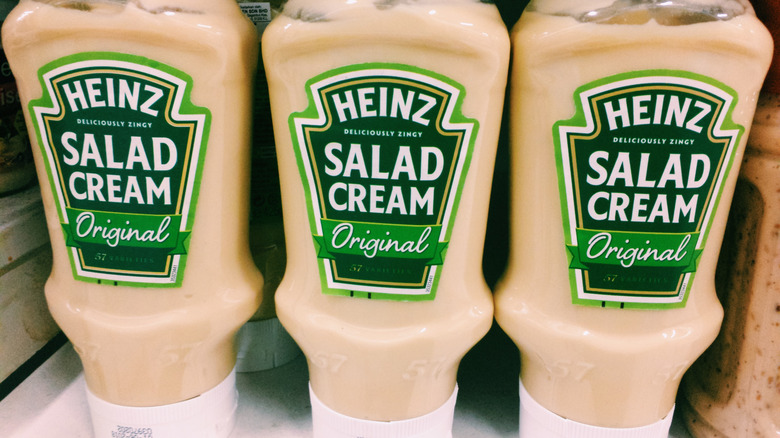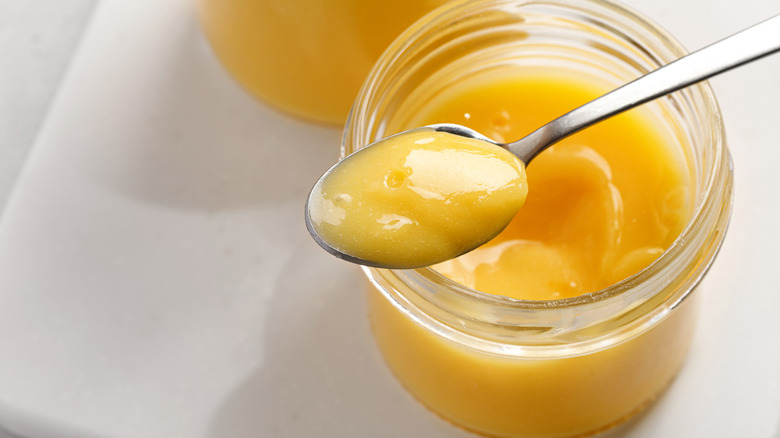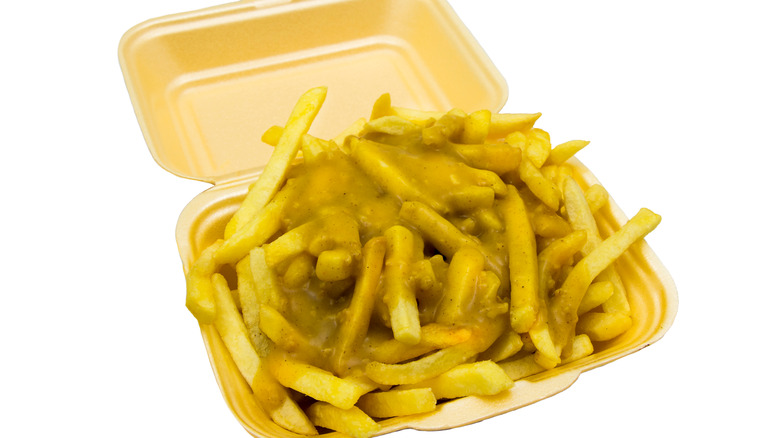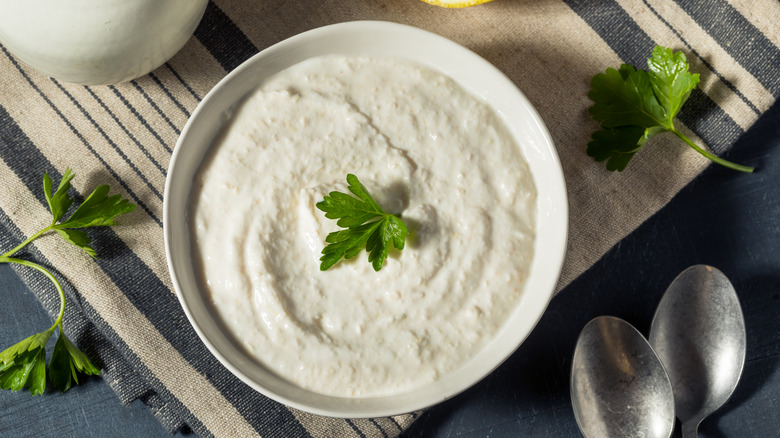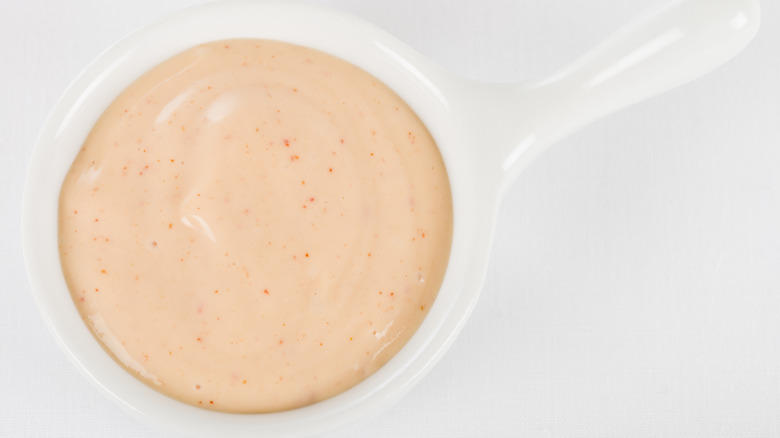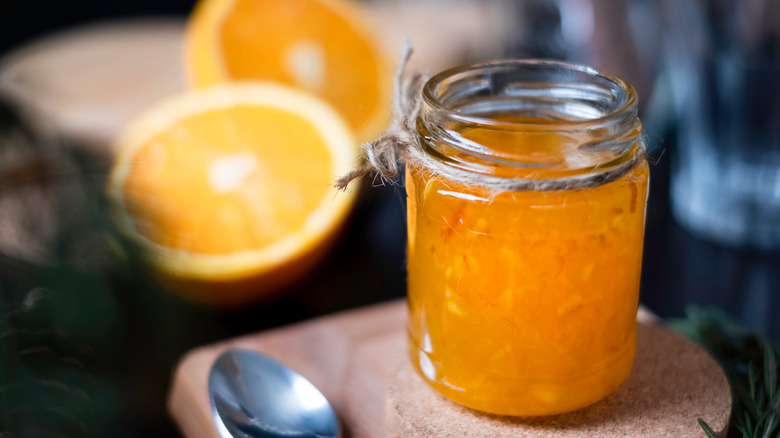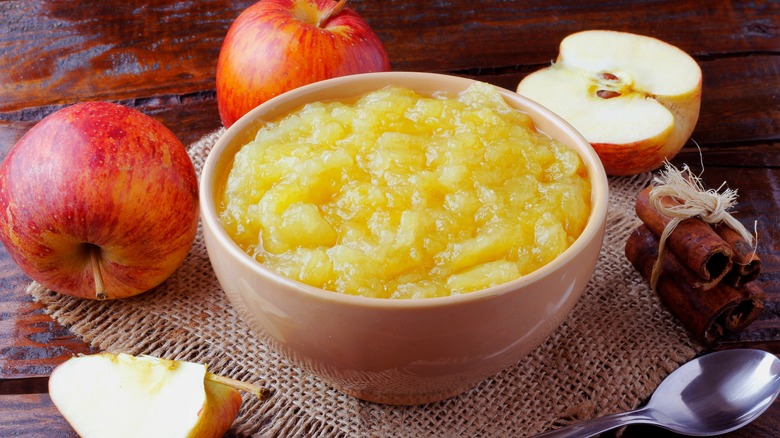17 British Sauces And Condiments You Should Know
Whether spooned over onto a Sunday roast, nestled into a ploughman's, slathered onto a bacon sarnie, or soaked up by pie and mash, Britons harbor an affinity towards sauces of all kinds. Sauces are such a mainstay in the cuisine that most restaurants will ask diners what sauces, rather than condiments, guests would like after a meal is set down before them.
Knowing what to ask for in these instances is often the key to unlocking a great meal punctuated with a hit of spice, an acidic punch, or herbaceous sweet-savory notes. The most well-loved and best-consumed sauces all have something in common; they are each powerful enough to cut through the richness of favorite comfort foods, providing the perfect mouth-pleasing balance of flavors. Anyone touting British cuisine to be bland is missing a trick, having surely overlooked one of its finest contributions – sauce. Here are seventeen essential British sauces and condiments to consider asking for at your next meal.
Worcestershire sauce
Some of the world's most popular dishes and successful sauces have come from mistakes, from oyster sauce to Worcestershire sauce. Better known in the U.K. as 'Worcester' sauce (pronounced "wuh-ster") the well-known sauce was named after where it was first (accidentally) produced.
This umami-rich sauce, now used in everything from a bloody mary to a non-traditional spaghetti bolognese, is the product of chemists/pharmacists John Wheeley Lea and William Henry Perrins, or Lea & Perrins as the company is now known. While the true origins are a mystery, it is suspected the duo was commissioned to create a product whose taste mimicked some curries in India. Unsuccessful in their attempts, a barrel of their experimental liquid was unintentionally left to ferment for months — far longer than was ever intended. A happy accident, the results of this long fermentation process have been popular since the brand released its first bottle in 1837.
Marmite
It is practically impossible to be indifferent about the taste of Marmite. Even its marketing team knows that, having acknowledged this fact with the brand's wildly successful slogan "Love it or hate it" to describe the products polarizing appeal.
The viscous, almost honey-like product can be a bit of an enigma to those outside of the U.K. Rather than a sweet taste as the dark, caramel texture would suggest, Marmite provides a malty and profoundly savory flavor. Made from yeast extract and rich in Vitamin B, Britons firmly in the love camp will happily spread a spoonful of the stuff onto hot buttered toast for a quick breakfast. A spoonful of Marmite into a pot of chili, steak marinade, or spaghetti sauce can also add an irreplaceable depth of flavor, even for those who aren't fans of eating the stuff on its own.
Piccalilli
Not to be confused with Piccadilly, the popular tourist area in central London, piccalilli is an equally popular British favorite condiment that isn't limited to the capital city alone. Made from pickled vegetables including but not limited to cauliflower, cabbage, radish, carrot, zucchini, and onions, piccalilli is often seasoned with fennel and mustard alongside turmeric, which gives the condiment its golden hue. Piccalilli is often eaten with decadent foods like meats and cheeses to provide balance and a burst of acidity.
Piccalilli is very likely to have been inspired by the flavors and ingredients of India due to British colonialism and contact between the two regions. By WWII, pickles like piccalilli and other preserving methods were standard amongst British households as rationing took hold. It became even more necessary to utilize and preserve as much produce from the summer growing season as possible, which is why pickled produce of all kinds (not just cucumbers) remains commonplace within British cuisine.
Mint sauce
With more than triple the number of sheep and lambs being reared as livestock than cows in the U.K — 33 million sheep compared to just 9.6 million cows in 2022 — it makes good sense that cooked lamb have their own dedicated condiments and sauces.
In springtime's lambing season, roast legs of lamb become increasingly popular, making for a traditional Easter lunch paired with other springtime vegetables and featuring on Sunday roast menus. Mint, which also springs to life once the colder months have subsided, is coupled with sugar and vinegar to create a perfectly-paired mint sauce, which brings out the lamb's naturally gamey flavor.
Using lamb and sheep for food over textiles and wool wasn't always so popular. The pairing of mint and lamb was made into law in the 16th century by Queen Elizabeth as a means of regulating the number of sheep slaughtered for food rather than used for wool and textiles. The insistence upon serving lamb with a bitter herb sauce was meant to deter the pairing rather than cement it into Britain's culinary traditions.
Onion gravy
A classic plate of bangers and mash (aka Cumberland pork sausages served on top of a bed of smooth mashed potatoes) would be a lack without a heavy-handed helping of salty, savory onion gravy. Like the rug in the movie "The Big Lebowski," the gravy really ties the dish together.
Made with beef broth or juices from the roasting tin, onions, Dijon or English mustard, and a splash of Worcestershire sauce, it's no wonder Britons love onion gravy. In fact, most British comfort foods practically demand to come swimming in it. Given the frequency with which clouds, winds, and rain dictate the day's activities and outerwear, it only makes good sense to fight fire with fire — or in this case, soggy rain puddles with pools of rich oniony gravy.
English mustard
Mustard comes in various flavors and heat levels, from the placid, traffic-light yellow Frenches that get slathered onto a hot dog to the ear-warming, tongue-tingling, packs-a-punch burst of Colman's English mustard. One of the main reasons for mustard's heat variation is down to the kind of mustard seed used. Colmans, and other English mustards like it, are made from a blend of white and brown mustard seeds. Typically, the darker the seed, the stronger the heat it packs. When mixed with water, the seeds will create a more potent taste but with a shorter shelf life before it dulls. Mustards made with vinegar, however, will have a milder but more long-lasting effect.
English mustard, made without vinegar, packs a punch, whether purchased in powder or pre-made form. Unless you're suffering from blocked sinuses, we recommend using it sparingly. A little on a sandwich, roast, or dressing really does go a long way.
Brown sauce
Visit any good cafe (short for cafeteria rather than a cafe) in the U.K., and you'll likely have to answer the question "red sauce or brown sauce" after placing your breakfast order. British food writer Felicity Cloake has even written about this exact cultural nuance in her recent book, aptly titled "Red Sauce Brown Sauce: A British Breakfast Odyssey." So, what exactly is brown sauce?
HP sauce, or brown sauce, has been making its way across British tables since the 1800s when grocer Frederick Gibson Garton developed it. Though the exact recipe will differ based on brand and recipe, brown sauce is generally made from a mixture of fruit including apples, dried apricots, and dates, combined with tomatoes, vinegar, molasses, and tamarind. Its sweet-meets-savory flavor makes it a comparable alternative to ketchup, with many Britons preferring it on their bacon sarnies or eggs.
Branston pickle
Rather than a sweet tooth (though classics like British fudge, Scottish tablet, and sticky toffee pudding would challenge that), the British have a special love for all things vinegary and pickled. This taste choice is a likely combination of the need for preserving produce due to various food shortages throughout British history like WWII, the influence of India and South Asian cuisine due to British colonialism, and the need to cut through the richness of some of the regions most well-loved comfort foods with a bit of acidity, tang, and crunch. Enter the popular condiment, Branston Pickle.
Made from crunchy vegetables including carrot, rutabaga, onion, and cauliflower, which are cut into small chunks and stirred through a jammy, sticky, sweet-meets-sour glaze, Branston pickle provides some much-needed pep and perk to accompany any ploughman's, thick slice of ham, or creamy quiche. We also love it slathered in the middle of a sharp cheddar grilled cheese sandwich.
Liquor
Not to be confused with alcohol-based spirits, liquor is a quintessential British Cockney classic that packs an enormous amount of London's East End history into each drop. The East End's busy docklands area of London has largely been known for its working-class residents throughout much of the city's history. Over the years, this area has also been a landing spot for many immigrants and refugees, including many Irish, Jewish, Bangladeshi, and South Asian diasporas.
British foods that came out of this area were made in response to the need for resourceful, energy-packed meals that would keep workers going. Foods like jellied eels and pie and mash were born out of this region during the Victorian era.
Eel, pie, and mash shops, though sadly a dying enterprise, were once a staple of the East End, with a few classic houses remaining. Considered by many to be the city's first fast food, a serving of pie and mash was considered incomplete until a ladle of liquor, a gravy-like parsley sauce often made with eel, had been spooned over the top. Though far and few between, there are still a few remaining pie and mash shops in Essex, London, and Kent worth visiting to experience the real deal.
Bread sauce
Bread sauce, like other culturally specific foods like Fluffernutter sandwiches, should be tried at least once if the opportunity presents itself, in the name of culinary anthropology — and of course, curiosity. And yes, bread sauce is actually made with bread.
Bread sauce is typically made from a combination of stale white bread, milk, and butter, infused with onion and warming spices like mace and clove or bay leaf for a bit of acidity and flavor. Its thick, almost porridge-like texture makes it a unique cross between gravy and a plate of mashed potatoes. Often served alongside gravy, cranberry sauce, or mustard to cut through its richness, bread sauce is a traditional accompaniment to roast dinners. You'll find it on the table for holiday meals like Christmas alongside a plate filled with turkey, roast potatoes, stuffing, Brussels sprouts, cranberry sauce, and bacon-wrapped cocktail sausages — just in case guests weren't full enough already!
Salad cream
If mayonnaise and miracle whip got together and had a baby, it would taste incredibly similar to British salad cream. Though admittedly, the name sounds like an oxymoron (salads crunch, not cream), salad cream is a one-stop shop for those who love the creamy, tangy flavors of coleslaw and potato salads, all in just one bottle.
Salad cream roots reach back to the 19th century when boiled dressings were devised when the price of oils made dressings like mayonnaise accessible to most due to their high cost. A similar and more cost-effective dressing-like consistency was achieved by emulsifying egg yolks with vinegar with low heat over a double boiler (hence the name boiled dressing). Boiled dressings were eventually mixed with dairy-based liquids like milk or cream to form the basis of what we now know of as salad cream.
Though it is a go-to dressing to top fresh raw vegetables or stirred into tuna or chicken salad, salad cream can also be used in place of a tartar sauce for fish fingers or a tangy dip to drag fries through. What can't salad cream do?
Lemon curd
Not quite a jam, not really a custard, lemon curd and other fruit curds sit in a unique in-between spot on the grocery store shelves. Despite their enigma-like status, make no mistake, lemon curd is a mainstay in British cuisine.
Much like preserves, clotted creams, and jams, lemon curd was a popular choice during the Victorian and Edwardian times of the 19th and 20th centuries. The lemon curd was often brought out to accompany a baked treat like a scone, crumpet, or toast served alongside tea. Following WWII, lemons, like many other provisions, were no longer available. Other household products like butter, sugar, and eggs were rationed, which meant lemon curd disappeared from tea time trays.
Eventually, the sweet-meets-tart curd made its comeback in the 1960s and has been a popular spread ever since. The tangy curd has become a popular ingredient in desserts as well, as is apparent when viewing "The Great British Baking Show." Though shoppers will be spoilt for choice when selecting a curd from the supermarket shelf, lemon curd is also a joy to make at home, for those so inclined.
Curry sauce
Like anywhere else in the world, British food, and its people, are not a monolith. The United Kingdom is comprised of a series of nuanced regional cuisines, cultures, influences, and favorites. One unique way to spot the differences in east to west, north to south, is to see what is on offer at the local chip shop.
Differences amongst fish and chip regions will include: what type of fish and other deep-fried foods are on offer? Do mushy peas come minted? And, what types of sauces can you order? One such sauce that separates itself from the rest is curry sauce, a thick, rich, curry powder seasoned sauce perfect for dipping your freshly fried chips.
Not just limited to fish and chips, curry sauce (and chips) shows up in many other outlets across the country, from Indian to Chinese takeout restaurants. Unique to the U.K. and a bit of an enigma to Americans,the combination of creamy, rich sauce flavored with the warming spices of curry powder showcases the blending of British, Chinese, and South Asian cultures, creating a unique product that can serve as a dipping sauce or gravy for each one.
Horseradish sauce
Glance at any menu offering a Sunday roast lunch of roast beef across the U.K. and you'll likely find it paired with a creamy-meets-spicy horseradish sauce to accompany it. According to Healthline, Horseradish root and its leaves have also been used medicinally, known for its antibacterial and anticancer properties and for treating some respiratory illnesses. All the more reason to slather it onto a perfectly pink slice of rare roast beef.
Horseradish has made its way from its ancient origins with the Egyptians and Greeks to Central Europe and onto the U.K., where it became a key component in a weekly Sunday tradition. Though initially consumed chiefly by country dwellers and the working classes, it has made its way into homes and pubs across the country and classes, grated fresh and mixed with crème fraîche, English mustard, and cream.
Marie Rose sauce
Marie Rose sauce was first made popular in Britain during the1960s and '70s alongside now-considered retro dinner party starters such as a classic, perfectly chilled prawn cocktail. The prawn cocktail was considered the height of dinner party elegance, made popular by famous British TV cook Fanny Craddock.
Though the origins of the name are not completely clear, there have been claims that there may be some association with the British wartime ship named the Mary Rose, later changed to Marie for more elevated French-sounding associations. The sauce is a simple combination of mayonnaise, tomato (largely ketchup,) and lemon juice. The sauce can then be tweaked with a dash of Tabasco or Worcestershire sauce, horseradish cream, or even a sprinkle of paprika. The pairing of prawns and Marie Rose sauce has become such a British classic it has even inspired a wide variety of prawn cocktail-flavored crisps (chips) in hopes of mirroring its likeness.
Marmalade
If the likes of Paddington wouldn't be caught dead without a marmalade sandwich-shaped security blanket tucked under his hat, you better believe most Brits sleep better at night knowing there's a jar of it tucked into their fridge or cupboard. There is something special about the bitter-meets-sweet taste of marmalade.
The origins of marmalade, alongside preserved fruits in general, date back to the Greek and Roman Empires, making its way to the U.K. in the 1600s. Made using the bitter, thick skin from Seville oranges, marmalade as a breakfast option first became popularized in Scotland. It took a little while before the Scottish tradition caught on. However, once it did in the late 1800s, it spread like wildfire.
Now varieties also include lemon, grapefruit, and lime — the pectin in the peel has been found to help the jelly set. Today there is something quintessentially British about starting the day with a hot cup of tea, a slice of hot toast slathered with butter, and a swipe of peel-speckled marmalade.
Bramley apple sauce
Unlike apple sauces in the U.S. which often come sweetened and sprinkled with cinnamon and nutmeg, apple sauce across the pond is a simple, paired-back affair. It's often served as an accompaniment to a delicious roast pork dinner, complete with crackling. The sauce is made from Bramley apples, known for their flavor and ease with which they break down into sauce. The peeled and stewed apples are then mixed with a touch of sugar, lemon, and sometimes a drop of dry, alcoholic cider before being served.
Pork and apple is a traditional British pairing, as the sweet, moist flavors of the sauce complement the earthy, salty, meaty flavors of roast pork. So much so is the case that even the apples were named after a local butcher, Matthew Bramley, who had purchased the land to grow the specific tree, which, no doubt complimented the meat he sold. During WWII, the planting of Bramley trees was encouraged as a food source when other resources were scarce. The cooking apple is also used in making apple crumbles and pies.
